 |
 |
 |
| |
Lipid effects in the ARTEMIS and TITAN trials: effects of demographics, HIV disease stage, treatment arm and lipid-lowering drugs
|
| |
| |
Reported by Jules Levin
9th International Congress on Drug Therapy in HIV Infection, Glasgow, UK, 9-13 November 2008
Mark Nelson,1 Andrew Hill2
1Chelsea and Westminster Hospital, London, UK; 2University of Liverpool, Liverpool, UK
AUTHOR CONCLUSIONS
Rises in lipid parameters during the ARTEMIS and TITAN trials were influenced by several factors. In the ARTEMIS trial, older patients tended to have larger rises in Total cholesterol and triglycerides. Baseline CD4 cell counts and HIV RNA levels were not associated with changes in lipids during this trial.
In both trials, DRV/r led to significantly smaller rises in Total cholesterol, HDL and triglycerides than LPV/r. The ratio of Total cholesterol/HDL remained stable over time in both treatment groups, for both trials.
In the TITAN trial, patients using EFV or NVP showed significantly greater rises in Total cholesterol, HDL and triglycerides.
In each trial, including or excluding data on lipid-lowering drugs had no effect on estimates of mean change in lipids over time.
Abstract
· The ARTEMIS trial (TMC114-C211; AntiRetroviral Therapy with TMC114 ExaMined In Naïve Subjects) evaluated lopinavir (LPV) with low-dose ritonavir (LPV/r) versus darunavir with low-dose ritonavir (DRV/r) 800/100mg qd in treatment-naïve patients, in combination with tenofovir/emtricitabine (TDF/FTC).
· The TITAN trial (TMC114-C214; TMC114/r In Treatment-experienced pAtients Naïve to lopinavir) evaluated LPV/r versus DRV/r 600/100mg bid in LPV-naïve, treatment-experienced patients with HIV-1 RNA >1,000 copies/mL, in combination with optimised NRTI/NNRTI combinations.
· The objective of this analysis was to determine the effects of baseline characteristics and use of lipid-lowering drugs on the changes in lipids during the two trials.
· Safety assessments were performed at screening, baseline, Weeks 2, 4, 8, 12, 16, 24, 36 and 48. Patients were required to fast for at least 10 hours before blood sampling for biochemistry tests.
· Fasting lipid parameters which were measured during the trials included Total cholesterol, low-density lipoprotein (LDL; calculated, for samples with triglycerides below 4.52mmol/L), high-density lipoprotein (HDL), triglycerides, apolipoprotein A1, Apo B, glucose and insulin.
· Analysis of covariance was used to correlate changes in each lipid parameter with baseline lipid levels, age, gender, and race, baseline CD4 cell count, HIV RNA, treatment arm (LPV/r versus DRV/r), and use of NNRTI (TITAN trial only) and lipid-lowering drugs (fibrates/statins).
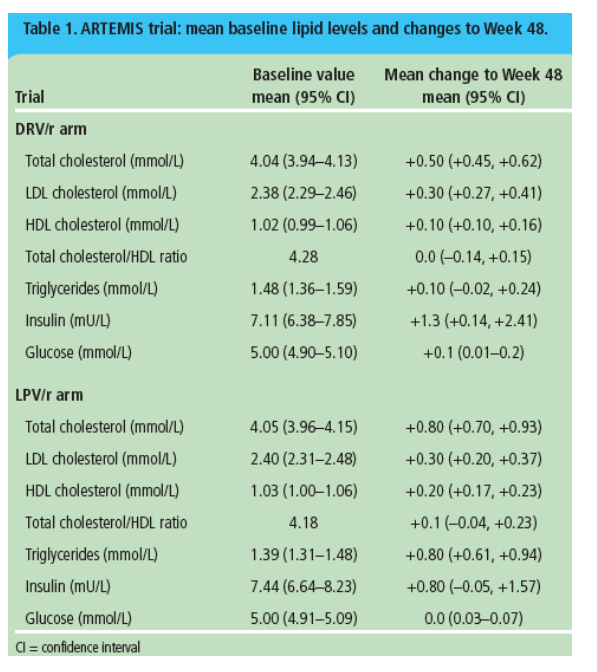
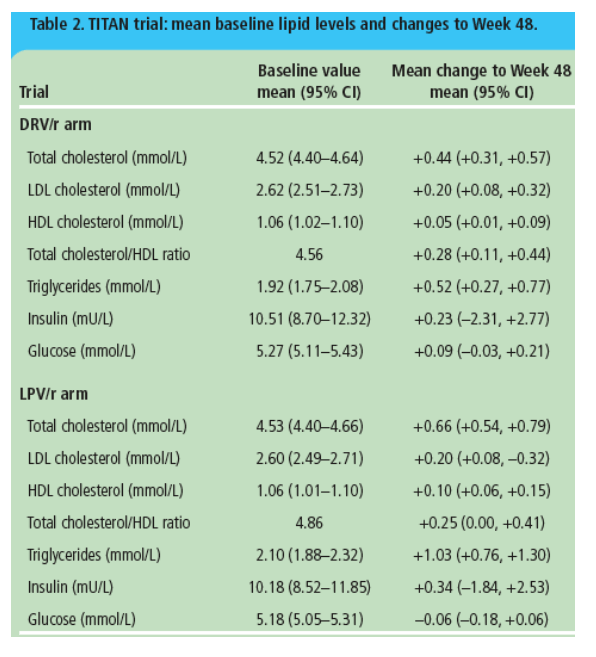
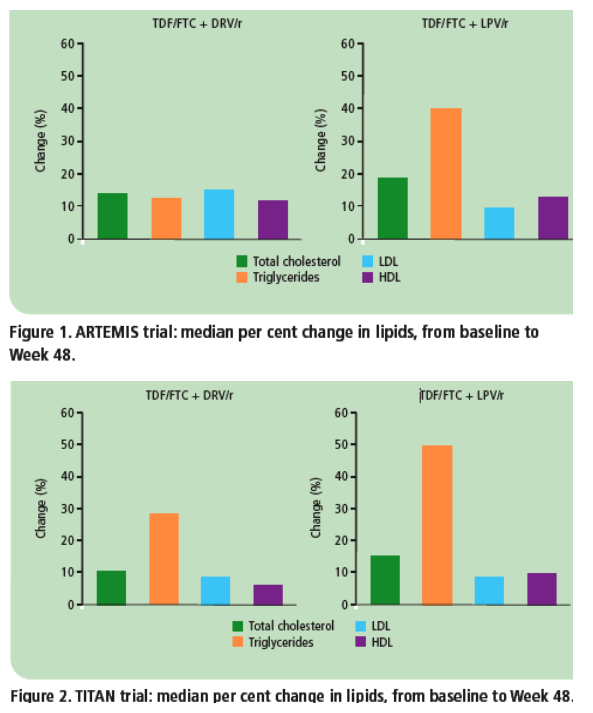
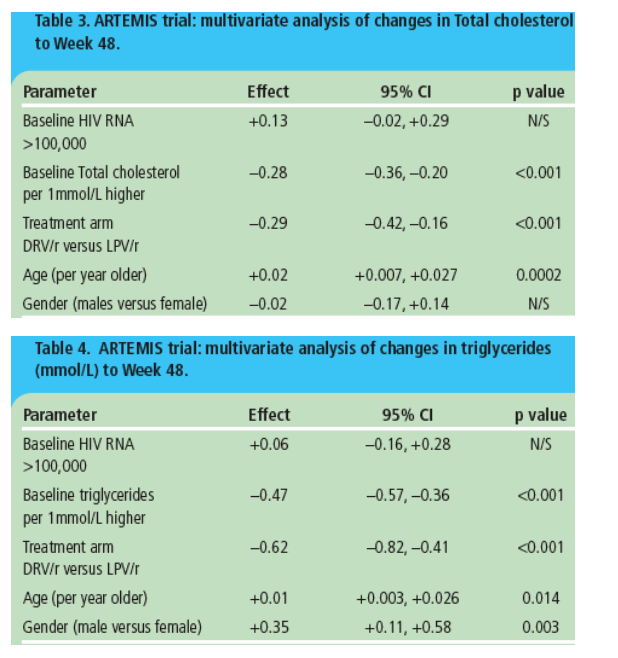
In TITAN, use of NNRTIs led to significantly greater rises in Total cholesterol. LPV/r led to significantly greater rises in triglycerides, Total cholesterol and HDL than DRV/r. There was no significant difference between arms in the Total cholesterol/HDL ratio at Week 48 (p=0.60). Data are shown in Tables 5 and 6.
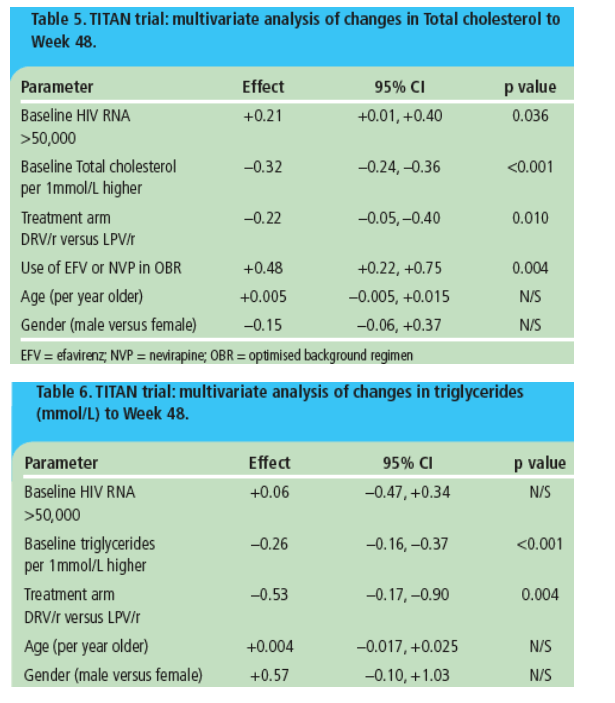
Use of lipid-lowering drugs is shown in Table 7. In both trials, including or excluding data from patients who used lipidlowering drugs, had little effect on the estimates of change in any lipid parameter for the overall treatment groups. Total
cholesterol/HDL ratios did not differ significantly between LPV/r and DRV/r in either trial.
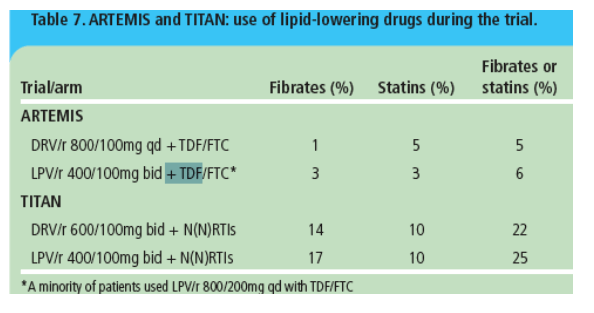
|
| |
|
 |
 |
|
|